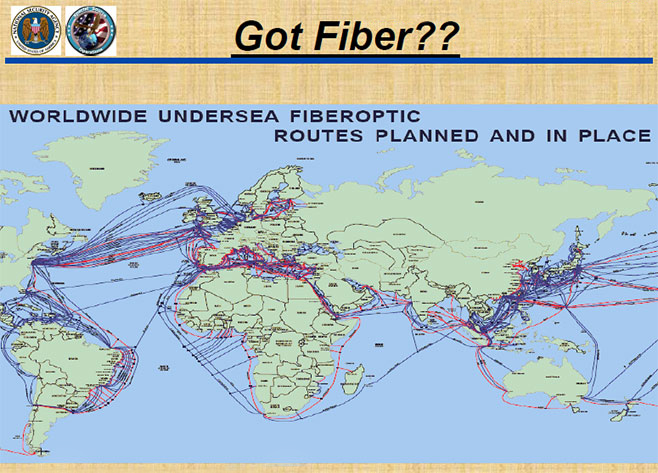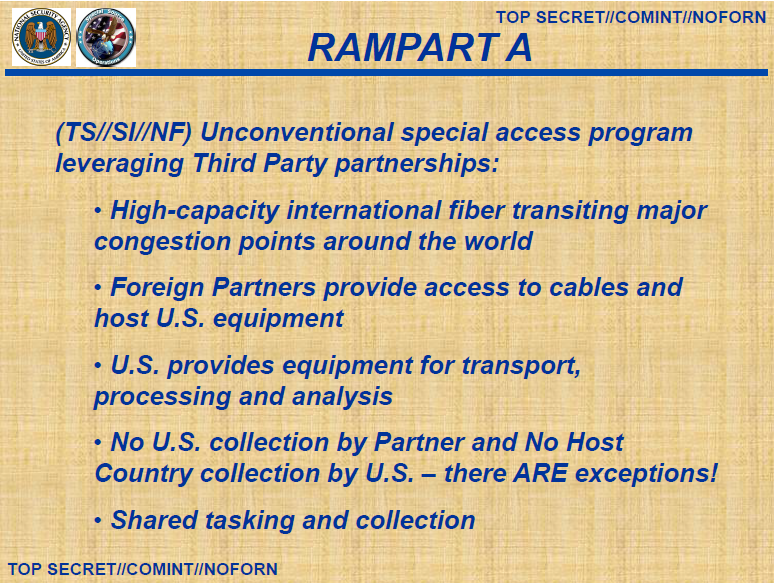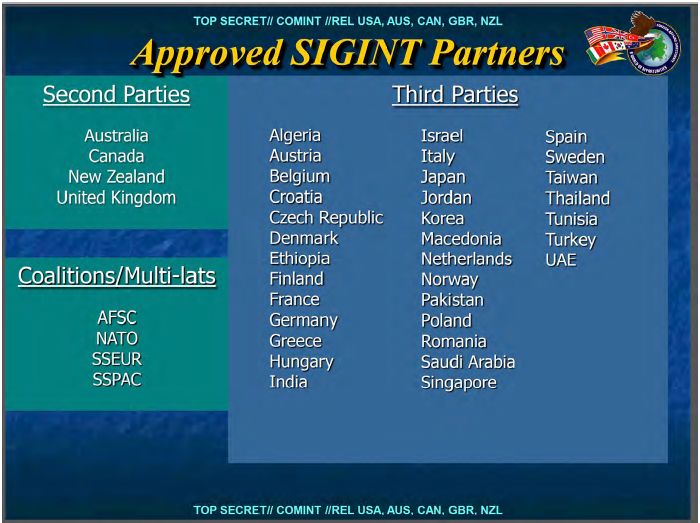How Secret Partners Expand NSA’s Surveillance Dragnet
WHISTLEBLOWING - SURVEILLANCE, 30 Jun 2014
Ryan Gallagher – The Intercept

Top-secret documents reveal how the NSA has established secret partnerships to spy on huge flows of private data.
18 Jun 2014 – Huge volumes of private emails, phone calls, and internet chats are being intercepted by the National Security Agency with the secret cooperation of more foreign governments than previously known, according to newly disclosed documents from whistleblower Edward Snowden.
The classified files, revealed today by the Danish newspaper Dagbladet Information in a reporting collaboration with The Intercept, shed light on how the NSA’s surveillance of global communications has expanded under a clandestine program, known as RAMPART-A, that depends on the participation of a growing network of intelligence agencies.
It has already been widely reported that the NSA works closely with eavesdropping agencies in the United Kingdom, Canada, New Zealand, and Australia as part of the so-called Five Eyes surveillance alliance. But the latest Snowden documents show that a number of other countries, described by the NSA as “third-party partners,” are playing an increasingly important role – by secretly allowing the NSA to install surveillance equipment on their fiber-optic cables.
The NSA documents state that under RAMPART-A, foreign partners “provide access to cables and host U.S. equipment.” This allows the agency to covertly tap into “congestion points around the world” where it says it can intercept the content of phone calls, faxes, e-mails, internet chats, data from virtual private networks, and calls made using Voice over IP software like Skype.
The program, which the secret files show cost U.S. taxpayers about $170 million between 2011 and 2013, sweeps up a vast amount of communications at lightning speed. According to the intelligence community’s classified “Black Budget” for 2013, RAMPART-A enables the NSA to tap into three terabits of data every second as the data flows across the compromised cables – the equivalent of being able to download about 5,400 uncompressed high-definition movies every minute.
In an emailed statement, the NSA declined to comment on the RAMPART-A program. “The fact that the U.S. government works with other nations, under specific and regulated conditions, mutually strengthens the security of all,” said NSA spokeswoman Vanee’ Vines. “NSA’s efforts are focused on ensuring the protection of the national security of the United States, its citizens, and our allies through the pursuit of valid foreign intelligence targets only.”
The secret documents reveal that the NSA has set up at least 13 RAMPART-A sites, nine of which were active in 2013. Three of the largest – codenamed AZUREPHOENIX, SPINNERET and MOONLIGHTPATH – mine data from some 70 different cables or networks. The precise geographic locations of the sites and the countries cooperating with the program are among the most carefully guarded of the NSA’s secrets, and these details are not contained in the Snowden files. However, the documents point towards some of the countries involved – Denmark and Germany among them.
An NSA memo prepared for a 2012 meeting between the then-NSA director, Gen. Keith Alexander, and his Danish counterpart noted that the NSA had a longstanding partnership with the country’s intelligence service on a special “cable access” program. Another document, dated from 2013 and first published by Der Spiegel on Wednesday, describes a German cable access point under a program that was operated by the NSA, the German intelligence service BND, and an unnamed third partner.
The Danish and German operations appear to be associated with RAMPART-A because it is the only NSA cable-access initiative that depends on the cooperation of third-party partners. Other NSA operations tap cables without the consent or knowledge of the countries that host the cables, or are operated from within the United States with the assistance of American telecommunications companies that have international links. One secret NSA document notes that most of the RAMPART-A projects are operated by the partners “under the cover of an overt comsat effort,” suggesting that the tapping of the fiber-optic cables takes place at Cold War-era eavesdropping stations in the host countries, usually identifiable by their large white satellite dishes and radomes.
A shortlist of other countries potentially involved in the RAMPART-A operation is contained in the Snowden archive. A classified presentation dated 2013, published recently in Intercept editor Glenn Greenwald’s book No Place To Hide, revealed that the NSA had top-secret spying agreements with 33 third-party countries, including Denmark, Germany, and 15 other European Union member states:
For any foreign government, allowing the NSA to secretly tap private communications is politically explosive, hence the extreme secrecy shrouding the names of those involved. But governments that participate in RAMPART-A get something in return: access to the NSA’s sophisticated surveillance equipment, so they too can spy on the mass of data that flows in and out of their territory.
The partnership deals operate on the condition that the host country will not use the NSA’s spy technology to collect any data on U.S. citizens. The NSA also agrees that it will not use the access it has been granted to collect data on the host countries’ citizens. One NSA document notes that “there ARE exceptions” to this rule – though does not state what those exceptions may be.
According to Snowden, the agreements that the NSA has in place with its partners are lax and easily circumvented. In a statement to the European parliament in March, he used Denmark and Germany as examples to describe how the NSA had effectively established what he called a “European bazaar” for surveillance.
“An EU member state like Denmark may give the NSA access to a tapping center on the (unenforceable) condition that NSA doesn’t search it for Danes, and Germany may give the NSA access to another on the condition that it doesn’t search for Germans,” Snowden said.
“Yet the two tapping sites may be two points on the same cable, so the NSA simply captures the communications of the German citizens as they transit Denmark, and the Danish citizens as they transit Germany, all the while considering it entirely in accordance with their agreements.”
Source documents for this article can be found here.
_______________________________
Ryan Gallagher is a Scottish journalist whose work at The Intercept is focused on government surveillance, technology, and civil liberties. His journalism has appeared in publications including Slate, the Guardian, Ars Technica, Huffington Post, the Sydney Morning Herald, the Financial Times, the Independent, and the New Statesman. Since 2011, Ryan has broken a series of national and international stories about controversial surveillance technologies, shining a light on spy agencies and uncovering links between Western technology firms and governments in repressive countries. He took home an award for his reporting at the 2013 Information Security Journalism Awards and he has received acclaim for his writing on a diverse range of subjects, encompassing everything from the FBI’s attempted infiltration of WikiLeaks to mass protests in Madrid and homelessness in England. Most recently, Ryan has been reporting from Rio de Janerio on the cache of secret files leaked by former National Security Agency contractor Edward Snowden.
Go to Original – firstlook.org
DISCLAIMER: The statements, views and opinions expressed in pieces republished here are solely those of the authors and do not necessarily represent those of TMS. In accordance with title 17 U.S.C. section 107, this material is distributed without profit to those who have expressed a prior interest in receiving the included information for research and educational purposes. TMS has no affiliation whatsoever with the originator of this article nor is TMS endorsed or sponsored by the originator. “GO TO ORIGINAL” links are provided as a convenience to our readers and allow for verification of authenticity. However, as originating pages are often updated by their originating host sites, the versions posted may not match the versions our readers view when clicking the “GO TO ORIGINAL” links. This site contains copyrighted material the use of which has not always been specifically authorized by the copyright owner. We are making such material available in our efforts to advance understanding of environmental, political, human rights, economic, democracy, scientific, and social justice issues, etc. We believe this constitutes a ‘fair use’ of any such copyrighted material as provided for in section 107 of the US Copyright Law. In accordance with Title 17 U.S.C. Section 107, the material on this site is distributed without profit to those who have expressed a prior interest in receiving the included information for research and educational purposes. For more information go to: http://www.law.cornell.edu/uscode/17/107.shtml. If you wish to use copyrighted material from this site for purposes of your own that go beyond ‘fair use’, you must obtain permission from the copyright owner.
Read more
Click here to go to the current weekly digest or pick another article:
WHISTLEBLOWING - SURVEILLANCE:

